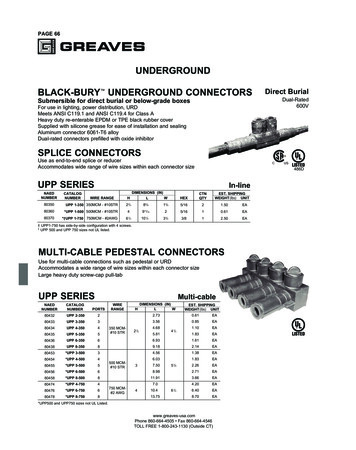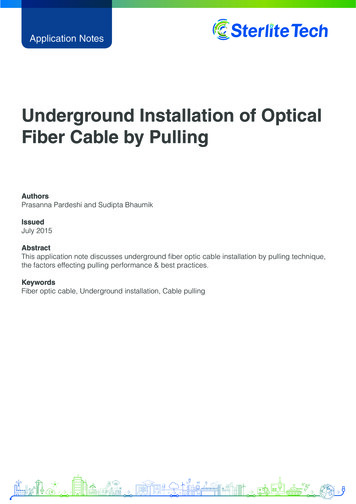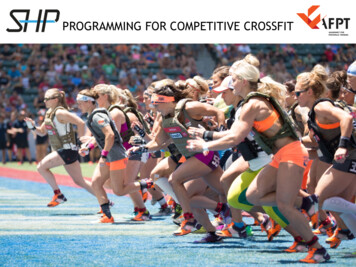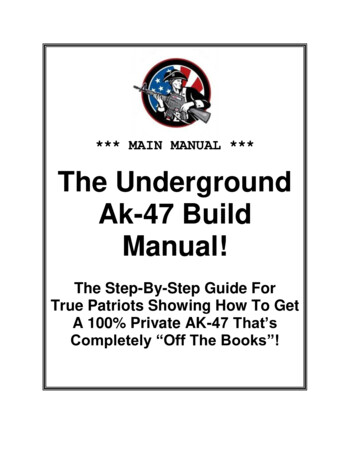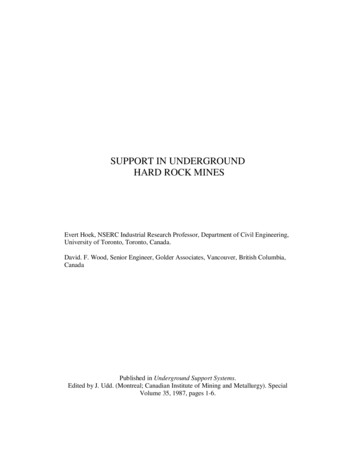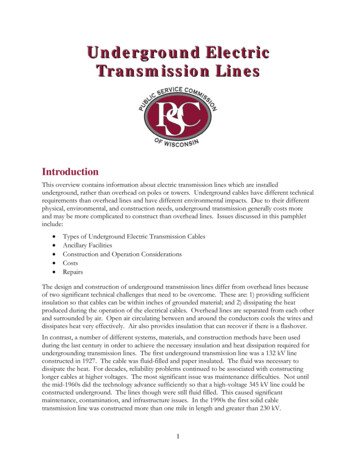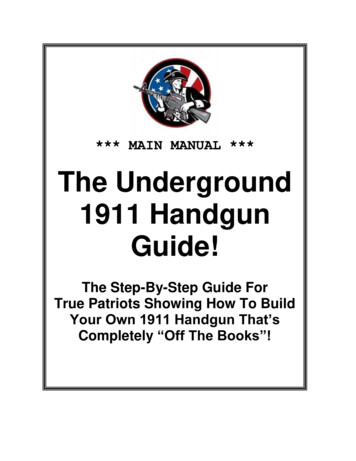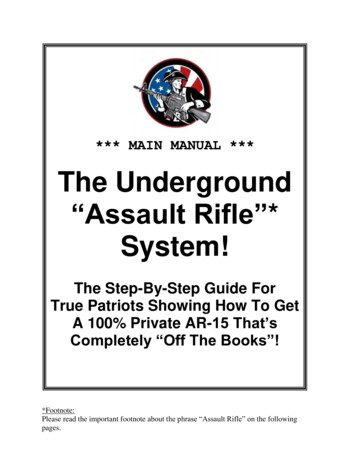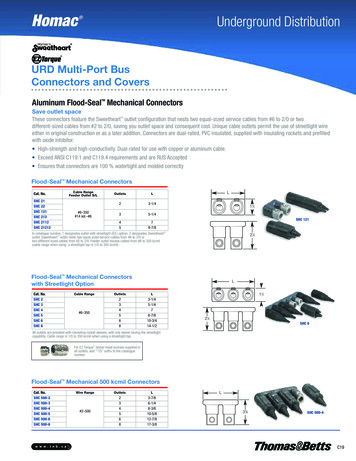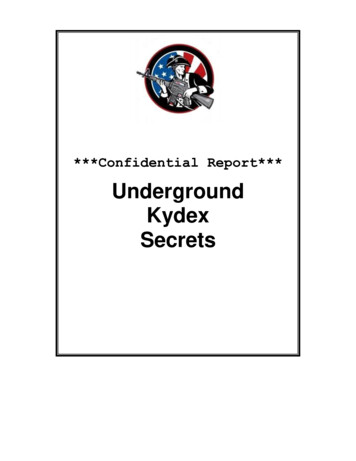
Transcription
***Confidential Report***UndergroundKydexSecrets
Underground Kydex SecretsUnderground Kydex SecretsBy Caleb Lee UGAR LLC 2014 and BeyondALL RIGHTS RESERVED. No part of this report may be reproduced or transmittedin any form whatsoever, electronic, or mechanical, including photocopying,recording, or by any informational storage or retrieval system without expresswritten, dated and signed permission from the author.DISCLAIMER AND/OR LEGAL NOTICES:The information presented herein represents the view of the authoras of the date of publication. Because of the rate with whichconditions change, the author reserves the right to alter and updatehis opinion based on the new conditions. The report is forinformational purposes only. While every attempt has been made toverify the information provided in this report, neither the author norhis affiliates/partners assume any responsibility for errors,inaccuracies or omissions. Any slights of people or organizations areunintentional. If advice concerning legal or related matters isneeded, the services of a fully qualified professional should besought. This report is not intended for use as a source of legaladvice. You should be aware of any laws which govern the topicsdiscussed herein in your city, country and state. Any reference toany person or business whether living or dead is purely coincidental.*** SPECIAL CONFIDENTIAL REPORT ***Page 2
Underground Kydex SecretsUnderground Kydex SecretsIn the last few years, Kydex holsters have become more and more popular for gunsand knives, taking the place of leather for overall popularity.This rise in popularity comes from the ease of working with Kydex, making it a greatmaterial for cottage industry manufacturers working out of their homes and do-ityourselfers who want the fun of making their own.Kydex is a thermoplastic acrylic-polyvinyl chloride. The word “thermoplastic” meansthat it is a plastic that can be heat formed.The rest of that gobbledygook refers to the specific chemical composition of theplastic.To mold Kydex, it is heated to a specific temperature and thenformed around a mold. For the sake of making your own gun orknife holster, you can use the gun or knife itself.Professional holster makers use plastic blanks, rather than usingthe gun. While there is little chance of damaging the gun in theprocess of making the holster, most guns today have polymerframes which are best not heated.There are several ways of molding the Kydex around the gun or mold, but in thisreport we are going to show you the most simple, using what is known as a bookpress.Vacuum forming is what is usually done by manufacturers of parts for airplanes andtransit buses, but that requires additional equipment.Originally, Kydex was designed for use in molding the parts used to finish out theinterior walls of airplanes. All those curving plastic parts that make airliners look sonice on the inside are made of Kydex or a similar material. The manufacturer, KydexLLC, has expanded their horizons, providing their material to a wide variety of otherindustries for use in equipment enclosures, furniture and even building interiors.Using it for holsters is actually only a very small amount of the overall use of Kydex.*** SPECIAL CONFIDENTIAL REPORT ***Page 3
Underground Kydex SecretsKydex is sold in three thickness of sheets, in a wide variety of colors. You can evenget a custom color made, if you are willing to buy 1152 square feet of it. That’senough to make over 2,000 holsters. The three standard thicknesses are: .060 – This is the most flexible, giving great definition. Most holsters are madeout of this thickness, although some manufacturers go for a thicker material forgreater durability. .080 – Medium thickness, combined the advantages of the other twothicknesses. .093 – Provides the most durable holster, although there is the least definition.Holsters made with this thickness of Kydex are likely to have greater gunretention, due to the increased stiffness of the material.Kydex comes already textured, preventing the need for polishing and fine finishing.About the only part of the holster that requires any true finishing work is the edge,where you will cut it. Even then, if you don’t want a shiny finish on the edge, you cansave yourself a lot of work.Due to how easy Kydex is to mold, you can make holsters and sheathes for literallyanything you can think of; cell phones, knives, multi-tools, tomahawks, entrenchingtools and compasses can all be housed in Kydex holsters.The only restriction is your imagination.Plus, with the incredible popularity and thousands of uses for Kydex – there is even anopportunity now to cash in on this trend and create a nice income stream to makesome money from a rewarding hobby and skill (we’ll cover this at the end of thereport).Let’s get started!*** SPECIAL CONFIDENTIAL REPORT ***Page 4
Underground Kydex SecretsWhat Will You Need in Order to MakeYour Holster?Although making Kydex holsters isn’t overly complicated, there are a number ofmaterials and tools you will need. Most of the necessary tools are fairly common toolsthat you would have if you are a do-it-yourselfer.The main thing you will need to buy are the Kydex itself, as well as the othermaterials used in the making of the holster.If you are only going to make one holster, then you will be better off buying a kit.This will include all the materials you need for a fairly reasonable price.However, if you are going to make a number of holsters, the kit isn’t all that good adeal; you’ll be better off buying the individual materials.If you decide to buy the individual materials, rather than buying a kit, you will need: Kydex – The Kydex is available in a wide variety of colors, in the threethicknesses mentioned above. For your first try, I’d recommend using thinnermaterial. Rivet eyelets – Although there are rivet eyelets made for each size of material,you can use the rivets designed for the .093 thick material for all threethicknesses. One-quarter inch diameter rivets are the most common for gun*** SPECIAL CONFIDENTIAL REPORT ***Page 5
Underground Kydex Secretsholsters and 3/16 inch rivets are used for knife and other small holsters. Theseare available in black, brass or chrome finish. Belt loops – There are a wide variety of belt loops and clips available for use inmaking Kydex gun holsters. Many of these readily adapt to use for cell phonesand other devices. Typically, they come with the mounting hardware, althoughsome do not. Be sure to check the listing to make sure that it comes withadequate hardware before buying. Barrel screws (Chicago screws) – These are a two part screw and barrel,designed for mounting belt loops through the rivets.There are a number of sources for buying Kydex and the other materials needed formaking Kydex holsters. Of these, the two largest suppliers, with the best selection are:Midwest Knifemakers Supply, LLC - http://usaknifemaker.com/KnifeKits - http://www.knifekits.com/vcom/index.phpDecorative studs, medallions or snaps can be added to a Kydex holster, although it isnot common. These are available from the same sources that you can get the materialsfrom.In addition to the materials for your Kydex holster, you will need a variety of fairlycommon tools. These don’t need to be the “best quality” tools, as you will not beputting them under a lot of stress.If you need any of these tools and do not have them, you might try checking withHarbor Freight; they sell a wide variety of inexpensive tools.*** SPECIAL CONFIDENTIAL REPORT ***Page 6
Underground Kydex Secrets Ruler – For measuring the material and laying out the holster. Any ruler willdo, although a transparent one is easier to work with. Grease pencil or soapstone – For marking the cutting lines on the Kydex. Utility knife – For rough cutting the Kydex. Toaster oven – You have to heat the Kydex to a hot enough temperature toform it. Some use a heat gun for this, but that is very hard to do, as you needboth hands to work with the Kydex. If you don’t have a toaster oven, a regularoven will work. You will not harm the oven in any way by using it for thisproject. Cookie sheet – To put the Kydex on in the oven. Heat gun – This is not absolutely necessary, but useful for final adjustments tothe holster. Infrared contact free thermometer – Probably the most important piece ofequipment you can have for the project. The Kydex needs to be heated to anexact temperature and this is the only way that you can verify that it is at theright temperature for working with. Press – The Kydex needs to be clamped together with whatever it is beingmolded around to cool. You can either buy a press or make one. I will discusshow to make one later in this report. Scroll saw – For cutting out the final edges of the holster. If you don’t have ascroll saw, a handheld jig saw can be used, although it will be much harder towork with. Another option is to use a coping saw. Belt sander – To clean up the edges of the two molded pieces of Kydex andmake them match each other. This is very important. A handheld belt sandercan be used in place of a stationary one, if it can be turned upside-down andmounted in a vice. A vibratory sander will not work well, as it doesn’t removematerial fast enough. Drill press – To drill the holes for the rivets. A handheld drill can be used if adrill press is not available. Rivet setter – This is the one piece of specialty equipment you will need tobuy. Both of the suppliers listed above provide rivet setters for both 1/4” and3/16” rivets. Without it, there is no way of properly forming the rivets.*** SPECIAL CONFIDENTIAL REPORT ***Page 7
Underground Kydex Secrets Arbor press – To use with the rivet setter, curling the bottom lip to curl overand causing it to lock. If you don’t have an arbor press, a drill press, largeclamp or vice can be used. It is also possible to strike the rivet setter with ahammer, although this must be done carefully so as to not damage the rivets. Buffing wheel – This is not an absolute requirement, although if you want theedges of your holster to be very smooth, you will need it. Buffing wheelstypically come with two soft wheels; you should replace one of them with asisal wheel. This is coarser and will clean up the edge better. If you don’t havea buffing wheel, a drum sander mounted in a drill or drill press will accomplishalmost the same thing, although it won’t truly polish the edge of the plastic.Professionals use fake guns and knives, called blanks, for making their holsters.However, you can accomplish the exact same thing by using the gun or knife that youwant to make a holster for.If you are using a polymer framed gun, be sure to insert a magazine in the magazinewell, to support it and prevent warping of the mag well.Let’s talk about one of the most important pieces of equipment you’ll need next .Making a PressThe press is needed to cause the Kydex to form around the gun or other object thatyou are making the holster for. While heating the plastic makes it pliable so that it willform, something has to hold it in the form you want while it cools.*** SPECIAL CONFIDENTIAL REPORT ***Page 8
Underground Kydex SecretsA fair amount of pressure is needed, in order to assure that the Kydex formsaccurately to the shape of the object that will be in the holster. The more pressureused, the greater definition of the detail of the object.A press doesn’t have to be complicated to be effective. You can make an adequatepress out of two pieces of plywood and two pieces of foam rubber. You sandwich theKydex and mold between the layers of foam and plywood, in the order of: PlywoodFoamMold (gun)KydexFoamPlywoodSince only one piece of the Kydex is molded at a time, making one half of the holster,the mold is placed on top of the Kydex, so that you can located it exactly as you want.If you were to place the Kydex on top of the mold, it might end up being twistedslightly. When the other side of the holster is molded, be sure to turn the gun over tothe other side.Once everything is put together it needs to be clamped as tight as reasonably possible.Bar clamps are the best way of doing this, especially the type that slide quickly beforebeing screwed tight. Another option is large C clamps or even a vice to hold ittogether.*** SPECIAL CONFIDENTIAL REPORT ***Page 9
Underground Kydex SecretsWhile any high density foam rubber will work for the press, most people use “KydexSheath/Holster Making Foam” available from the same suppliers. This is a black, highdensity, neoprene foam. The foam can be purchased in 12” x 24” sheets, making itideal for a 12” x 12” press. The foam will not last forever, as the heat from the Kydexdamages it. You can make a number of holsters from one set of foam, but when itstarts to crush, you will need to replace it.It is not absolutely necessary, but many experienced holster makers say that coveringthe foam with simple cotton material, like that which is used for pillow cases. Thisallows the Kydex to slide over the foam more smoothly, preventing problems whilemolding.*** SPECIAL CONFIDENTIAL REPORT ***Page 10
Underground Kydex SecretsSteps to Forming a HolsterMaking a Kydex holster is a fairly involved process, with a lot of steps; however,none of the steps are very complicated. The material and the design are veryforgiving, in the case of error.If the Kydex itself doesn’t mold like you want, you can reheat it and mold it onceagain. That’s one of the beauty’s of this system; the ability to salvage any mistakesand turn them into victories.Your first Kydex holster may be a bit challenging to make, simply because it is thefirst time you’ve done it. You should see the first one as a learning experience andexpect it to take longer. Once you’ve finished that one however, you’ll be able to dothem much faster and easier.1. Design how you want to design the holster – Kydex holsters can take onliterally any design you want them to.
Holsters made with this thickness of Kydex are likely to have greater gun retention, due to the increased stiffness of the material. Kydex comes already textured, preventing the need for polishing and fine finishing. About the only part of the holster that requires any true finishing work is the edge, where you will cut it. Even then, if you don’t want a shiny finish on the edge, you can
